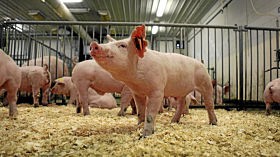Does anyone remember Margaret Atwood's dystopian novel Oryx and Crake? It concerned, in part, unscrupulous scientists who bred genetically-modified chickens that were all breast -- no heads or tails or legs. Atwood's vision confirmed the worst fears of anyone who opposes GMO's. It's also, it turns out, not entirely implausible, which has environmentalists up in arms.
Until recently, scientists at Ontario Pork, an industry organization, and the University of Guelph in Canada (hey, Atwood's Canadian, too! Is this a coincidence?) were conducting a long-term research study on the Enviropig, a breed of swine that Ontario Pork trumpeted as the first genetically-modified animal sold for human consumption. Unlike Atwood's chickens, the Enviropig looked like a pig. It was not all belly, or anything sexy like that. Its great attraction was that it was able to digest phosphorus which, researchers claimed, was better for the environment.
Two weeks ago, though, after thirteen years and $5 million (some of which came from government grants), Ontario Pork decided to pull its funding of the Enviropig project, effectively putting it into hibernation -- at least the part that involved breeding a herd of pigs.
On its website, the company explained that it thought it would be best to redirect its research dollars. But Ontario Farmer, which broke the story, suggests that Ontario Pork pulled back on the project because of a general reluctance among consumers to buy (and eat) genetically-modified meat.
Environmentalists rejoiced. Not only did Ontario Pork's decision confirm their belief that all GMOs are evil, they suspected that the company's motives were not all that pure in the first place.
Regular pigs can't digest phosphorus in cereal grains. So it comes out in their shit. Phosphorus is a source of major pollution. Enviropigs, however, have been genetically-modified (using genes from mice and bacteria) to produce an enzyme in their saliva that helps them digest phosphorus and produce, in theory, more environmentally-friendly manure. They also get maximum nutritional value from their feed.
David Hobson, an official at the University of Guelph, estimated that the Enviropigs could save farmers in feed costs and that the pigs would be ready for market sooner than conventionally bred swine.
John Phillips, a molecular biologist at the University of Guelph and one of the researchers, told Reuters in 1999, at the start of the project, that the Enviropig would allow farmers to increase the size of their herds. "Pork producers live under very stringent environmental regulations and can only raise so many hogs per hectare," he said. Most of those environmental regulations involved phosphorus levels. With Enviropigs, in theory, farmers could have more animals but produce the same amount of waste. Which could be interpreted to mean one thing: bigger factory farms.
In any case, although Ontario Pork tried for several years to license the technology in Canada, the U.S. and China, it failed to find a buyer. Without a commercial sponsor -- and the prospect of someday recouping its investment -- it didn't seem worthwhile to continue to give money to the university in order to breed the Enviropigs.
The genes are on ice, though, in case someday someone figures out a way to sell a GMO.






